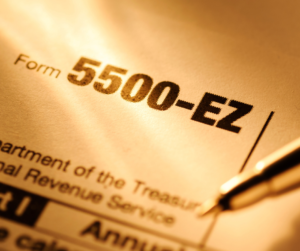
IS FORM 5500 REQUIRED FOR OUR WELFARE PLAN?
Under the Employee Retirement Income Security Act of 1974 (ERISA), Form 5500 must be filed annually for employer-sponsored welfare plans with 100 or more participants as of the beginning of the plan year. To count the number of participants, include covered employees, retirees, and primary COBRA beneficiaries, but do not include dependents.
Welfare plans include plans for medical, dental, vision, life, accident, and disability benefits, as well as health flexible spending accounts (HFSAs) and health reimbursement arrangements (HRAs). If the plan includes group insurance coverage, information about the insurance policy must be reported on Schedule A as part of the Form 5500 filing.
Most welfare plans are unfunded, which means all benefits are paid through group insurance contracts, or directly from the employer’s general assets, or a combination of both. In that case, the filing will be comprised of the three-page Form 5500 only, or the Form 5500 with one or more Schedules A if the plan includes group insurance coverages. No other schedules apply.
On the other hand, if the plan is funded (e.g., a benefits trust), Form 5500 must be filed regardless of the number of participants and additional schedules may be required. Funded plans are uncommon and outside the scope of this discussion.
The following plans are exempt from ERISA; therefore, Form 5500 does not apply:
▪ Plans sponsored by governmental employers and certain church plans;
▪ Most voluntary plans (e.g., employee-pay-all after-tax insurance plans without any employer sponsorship or contribution);
▪ Payroll practices (e.g., unfunded vacation and sick pay); and
▪ Plans maintained solely to comply with state workers’ compensation, unemployment, and weekly disability insurance laws, without providing additional benefits.
WHEN IS FORM 5500 DUE AND HOW IS IT FILED?
Form 5500 and any required schedules must be filed electronically using the Department of Labor (DOL) EFAST2 electronic filing system. Paper filings are no longer accepted. To prepare and file the form and any schedules, you may use approved third-party vendor software or the DOL’s web-based filing system IFILE.
Filing is due within seven months after the end of the plan year. For instance, for calendar year plans, the due date is July 31 of the following year (or the next business day if July 31 falls on Saturday or Sunday).
The due date can be extended by two and one-half months if the employer mails a simple Form 5558, Application for Extension of Time, no later than the original due date. (Instructions for U.S. mail or overnight delivery are included with the form.) In very rare cases, the IRS denies the request. Normally, the IRS does not respond which means the extension is automatically granted. Later on, when filing Form 5500, be sure to check the appropriate box in Part I, D, to indicate that the due date was extended by filing Form 5558.




